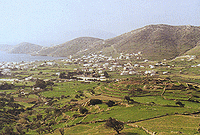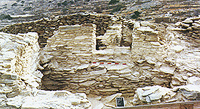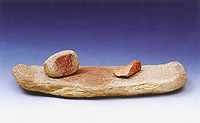The settlement of Skarkos is situated on a hill in the most fertile area of Ios, in Kampos, at a small distance from the modern port of the island. It occupies 11.000 square metres and is until now the largest and best preserved settlement of the Early Cycladic II period (Syros-Keros culture, 2700-2400/2300 BC). The rectangular, entirely stone-built buildings are comprised of the ground floor, an upper floor and an enclosed yard and are preserved at 3-4 metres high! They are built on different terraces -the natural relief of the hill- and form insulae. The planning of Skarkos is comparable to the insulae building system known from Poliochni on Lemnos which is applied in the north Aegean from the beginning of the 3rd millenium BC. Movement in the settlement was ensured by streets of 1-2 metres wide as well as public squares. Moreover, it remains unknown whether this settlement of Ios was enclosed by a defensive wall when it was thriving, in the Early Cycladic II. The study of architecture in combination with the variety and distribution of the mobile finds (ceramics, tools, animal bones, etc), contribute to the restoration of the functions of the rooms and shed light on economic sectors of the economy of the Cycladic society of Skarkos. Millstones and mortars for the grinding of cereals and legumes, fixed and mobile clay hearths for cooking, as well as bones of goat and sheep, remains of snails and urchins which are all associated with the preparation of meals, cooking and eating were found in the ground floors and yards of houses. Living spaces and storerooms for vases and goods are discerned on the storeys. The pithoi 1-1,30 metres high, destined for the storage of mainly cereals reveal the intense exploitation of fertile soils around the settlement. Apart from agriculture, animal husbandry, fishing and trade for ensuring raw materials (obsidian, metals), specialized activities such as pottery -signatures, the so-called "potters' marks" are preserved on vases-, stone carving for the manufacture of tools and marble vases and figurines, bone carving and metalworking, are however identified in the settlement. The use of mortars for the pulverization of blue (azurite) and red (ferrous) pigments for the adornment of the human body and the decoration of marble statuettes is remarkable. The blue pigment was in fact preserved in bone tubes (chromatothikes), which are comprised in the finds. Finally, the clay sealings indicate the need for controlling the agricultural production and the organization in the distribution of goods. The possession of such seals reveals the existence of economic affluence and social differentiation in the community of Skarkos.
|
 |
|
|
Ios. View of the hill of Skarkos.
|
||
 |
||
|
Ios, Skarkos. View of building A.
|
||
 |
||
|
Ios, Skarkos. Mortar and pestle
with signs of red colour and remains of red mineral colour.
|
||